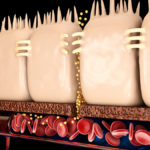By David Blyweiss, M.D., Advanced Natural Wellness
November 3, 2014
- Do you have undiagnosed gluten intolerance?
- What to watch for on a gluten-free diet
- Here’s your best bet…
These days I find that a lot more of my patients are embracing a gluten-free diet. This is something that’s absolutely necessary if you have celiac disease. But today we’re finding that many people without celiac disease are also sensitive to gluten.
Now, you might automatically think signs of gluten intolerance and sensitivity are limited to abdominal pain, diarrhea (or constipation), and bloating. But that’s not the case.
Gluten could be what’s causing your bone and joint pain. It can leave you feeling fatigued, with a bad case of brain fog. Headaches, muscle cramps, rashes and depression have also been linked to gluten intolerance.
Because of this wide range of symptoms, gluten sensitivities often go undiagnosed. So, it’s no surprise that more and more people are taking action and going gluten-free in the hopes of improving their own well-being.
Open your arteries, improve blood flow for a new health miracle...
Did you know your circulatory system has over 60,000 miles of arteries, veins and other blood vessels, if stretched end to end?
But as you age, your blood vessels undergo changes, which may cause them to stiffen, thicken and get clogged.
GOOD NEWS! Doctors have now identified a “Miracle Molecule” inside your arteries that helps OPEN your arteries and IMPROVE blood flow.
It’s what Dr. Valentin Fuster calls it, "One of the most important discoveries in the history of cardiovascular medicine."To you, that means...
- Healthy blood pressure
- Sharper mind and memory
- Skyrocketing energy and muscular strength
- Increased pleasure and passion in the bedroom
- Improved circulation to every cell and organ in your body
Go here to discover a new natural way to significantly boost the levels of this miracle molecule in YOUR body NOW!
If you’re anything like they are, I’ll bet you’ve noticed there are a lot of gluten-free products showing up on your grocer’s aisles these days. You might even be stocking your shelves with them, hoping to get rid of your aches, pains, fatigue and abdominal discomfort once and for all.
Well, today I have some news for you on that front. And it might solve that gluten-free puzzle once and for all.
Gluten is a protein found in grains like wheat, barley, rye and any foods made with these grains. You’ll also find glutens in baked goods (such as bread and cereal), gravies, pasta, soups, and salad dressings.
But, whew! When it comes to reading those labels, how do you really know what constitutes gluten? Is it the modified food starch, natural flavor, or hydrolyzed vegetable protein? Maybe it’s some of those words you can’t even pronounce, like secale cereale or triticum vulgare.
It’s hard to know for sure. That’s what makes it so easy to latch on to products that are labeled “gluten-free.” But what are you getting yourself into when you buy these products?
The World's Quickest Solution for Ending Prostate and Urinary Misery
This has recently been revealed to be one of the only real breakthroughs in prostate health.
The seeds of a strange fruit (sometimes called "Chinese Apples") hold powerful phytonutrients that are a revolution in prostate health.
In fact, UCLA and Veterans Administration research have now proved this to be true.
Not only that, but it may be the worlds quickest solution for ending prostate misery.
Simply stated, these phytonutrients represent a huge step beyond beta sitosterol, saw palmetto, and other phytosterols alone.
Simply click HERE if you want to have fast prostate relief...restful, uninterrupted sleep...no more constant "urges to go"...enhanced virility...and optimal prostate support for life.
First off, it turns out “gluten-free” doesn’t actually mean gluten-free. In fact, what it really means is that the food product contains less than 20 parts per million (ppm) of gluten. And you can bet a lot of those products are right at the 20 ppm mark.
That might be fine for some people. But it doesn’t work for everyone.
You see, damage from gluten is cumulative. So, even small amounts of it can build up in your body and cause health complications over time. In fact, less than a teaspoon of gluten can trigger the release of the intestinal protein “zonulin,” causing a short-term abnormal increase in intestinal permeability, otherwise known as leaky gut.
That’s why it’s important to go truly gluten-free, not “sort of” gluten-free, as soon as possible.
Many of those labels are tricky, too. Some say they’re “not made with gluten-containing ingredients.” That’s not the same as saying the product is gluten-free. And, it means they don’t have to follow the FDA’s 20 ppm rule. So, who knows how much gluten they really contain?
I’m also very concerned about other ingredients you’ll find in packaged foods that carry the gluten-free claim. Most of them are nothing more than junk food, filled with added sugars, salt, trans fats, preservatives, artificial ingredients, corn, rice and other inflammatory additives.
That’s what happens. We see a label that sounds healthy. Then we forget to look at the nutritional panel and ingredient list to find out what’s NOT healthy about it.
I know these foods are easy and convenient. But I have a plan of action that will serve you much better.
If you suspect your body can’t handle gluten, avoiding it is key. But, as you can see, purchasing products that scream “gluten-free” on their labels might not always be your best bet.
The best way to wipe gluten out of your diet completely is two-fold.
First, steer clear of any food that contains wheat, spelt, kamut, barley, semolina, durum and rye. You should also avoid oats. Oats don’t contain gluten, but are often contaminated with gluten in the field or during storage or processing.
You don’t have to give up grains altogether. Some gluten-free grains I recommend include amaranth, buckwheat, millet and quinoa.
Second, go natural. Forget the packaged foods altogether and load your plate with the good stuff. Organic fruits and vegetables should make up 87% of your diet. Fill the remaining 13% with wild-caught fish, organic free-range poultry, and grass-fed meats.
When it comes to the symptoms of gluten intolerance and sensitivities (and many other health disorders), the old saying, “You are what you eat,” is a solid truth.
Sources:
Sapone A, et al. “Spectrum of gluten-related disorders: consensus on new nomenclature and classification.” BMC Med. 2012 Feb 7;10:13.






